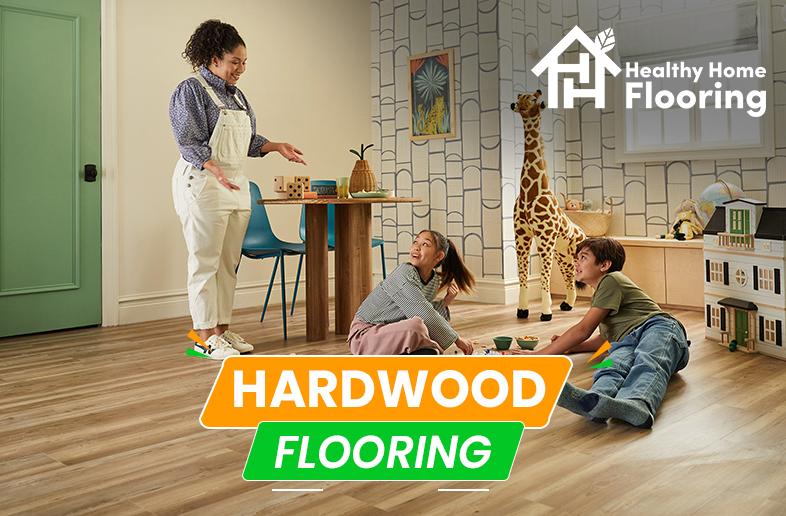Many homes are beautified by the natural warmth and elegance of wood floors. However, over time, these floors can become slippery due to wear and tear or changes in humidity. This poses a safety hazard, especially for young children and the elderly. If you find yourself in this situation, don’t despair! This comprehensive guide will provide you with detailed steps and expert advice on how to fix a slippery wood floor and restore its safety and shine.

Image: www.healthyhomeflooring.co
Understanding the Causes of Slippery Wood Floors
Before embarking on the repair process, it’s essential to understand what causes wood floors to become slippery. Several factors can contribute to this issue:
Wear and tear: As wood floors are subjected to foot traffic, the protective finish can gradually wear down, exposing the bare wood. This surface becomes more prone to becoming slick when exposed to moisture or dirt.
Lack of traction: Certain types of wood finishes, such as polyurethane or wax, can create a smooth surface. When combined with water, spills, or debris, this smoothness can lead to a slippery surface.
Humidity changes: Wood is a hygroscopic material, meaning it absorbs and releases moisture from the air. When humidity levels fluctuate, wood floors can expand or contract. This movement can cause tiny cracks or gaps in the finish, compromising its effectiveness and leading to slipperiness.
Spills and dirt: Household spills, dirt, and oil can create a film on the flooring surface, further reducing traction and increasing the risk of slips and falls.
Step-by-Step Guide to Fixing a Slippery Wood Floor
Now that we’ve identified the potential culprits, let’s dive into the step-by-step solution to fix a slippery wood floor:
1. Clean the Floor Thoroughly
Start by giving your wood floor a thorough cleaning. Use a vacuum to remove any dirt or debris and follow with a damp mop. Avoid using harsh chemicals or abrasive cleaning agents, as they can damage the finish.

Image: www.pinterest.com
2. Sand the Floor (if necessary)
If the floor is significantly worn or damaged, sanding may be necessary to create a fresh, even surface. Use a fine-grit sandpaper and sand in the direction of the wood grain. Be sure to vacuum up the dust thoroughly after sanding.
3. Apply a Non-Slip Finish
Once the floor is sanded (if necessary), it’s time to apply a non-slip finish. There are several types of non-slip finishes available, such as:
Aluminum oxide grit: This is a mineral that adds a grainy texture to the floor, enhancing traction.
Waterborne polyurethane with anti-slip additives: This finish provides both protection and traction.
Oil-based polyurethane with anti-slip agents: This finish offers excellent durability and slip resistance.
Choose the finish that best suits your needs and follow the manufacturer’s instructions for application. Allow the finish to dry completely.
4. Add Rugs and Mats
Although applying a non-slip finish provides long-term protection, consider strategically placing rugs and mats in high-traffic areas. This adds an extra layer of traction and prevents slips and falls.
5. Keep the Floor Clean
Regular cleaning is crucial for maintaining a non-slip wood floor. Sweep or vacuum frequently to remove dirt and debris. Damp mop the floor as needed with a neutral cleaner. Avoid excessive moisture, as it can damage the finish.
Additional Tips for Preventing Slippery Wood Floors
In addition to the steps outlined above, here are some additional tips to prevent wood floors from becoming slippery:
Use proper footwear: Avoid wearing shoes with slick soles or high heels on wood floors.
Trim pet nails regularly: Long pet nails can scratch and damage the floor finish, compromising its non-slip properties.
Maintain consistent humidity: A humidifier can help maintain a consistent humidity level in your home, preventing the wood floor from expanding or contracting.
Avoid using certain cleaners: Avoid using ammonia-based cleaners or oil soaps, as these can damage the floor finish.
How To Fix A Slippery Wood Floor
Conclusion
By following these steps and tips, you can effectively fix a slippery wood floor, restoring its safety and beauty. Remember to clean the floor regularly, apply a non-slip finish, and consider placing rugs in high-traffic areas. With proper care and maintenance, you can enjoy your wood floors for years to come without worrying about slips and falls. If you have any further concerns or require professional assistance, don’t hesitate to consult with a qualified flooring contractor.